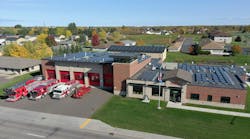Cedar Creek Energy Installs Solar Array at Wisconsin Fire Department to Support EV Fleet Expansion
Cedar Creek Energy has completed a solar photovoltaic (PV) array at the Superior Wisconsin Fire Department headquarters, making it the first municipal solar initiative in Superior.
Through the partnership, which sought to equip the fire department’s infrastructure for an eco-friendly future, Cedar Creek Energy installed a 153.1 kWh DC solar array to support the department’s plans to expand its EV fleet within the next three to five years – including the potential addition of an all-electric fire truck.
The solar array will also significantly reduce the fire department’s carbon emissions – preventing over 267,000 lbs. of CO2 emissions annually.
“Our collaboration with the Superior Fire Department embodies our vision for a sustainable future,” said Rob Appelhof, CEO of Cedar Creek Energy. “This project is an example of environmental stewardship and innovation. We’re honored to have contributed to this historic initiative and excited for the department’s green journey ahead.”
About the Author
EnergyTech Staff
Rod Walton is head of content for EnergyTech.com. He has spent 17 years covering the energy industry as a newspaper and trade journalist.
Walton formerly was energy writer and business editor at the Tulsa World. Later, he spent six years covering the electricity power sector for Pennwell and Clarion Events. He joined Endeavor and EnergyTech in November 2021.
He can be reached at [email protected].
EnergyTech is focused on the mission critical and large-scale energy users and their sustainability and resiliency goals. These include the commercial and industrial sectors, as well as the military, universities, data centers and microgrids.
Many large-scale energy users such as Fortune 500 companies, and mission-critical users such as military bases, universities, healthcare facilities, public safety and data centers, shifting their energy priorities to reach net-zero carbon goals within the coming decades. These include plans for renewable energy power purchase agreements, but also on-site resiliency projects such as microgrids, combined heat and power, rooftop solar, energy storage, digitalization and building efficiency upgrades.
